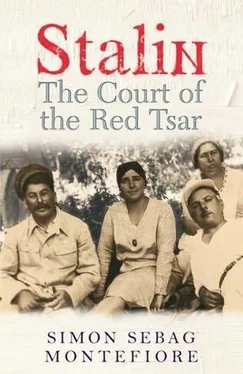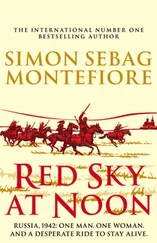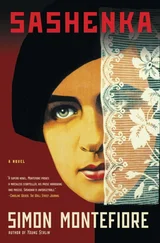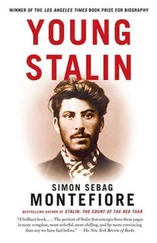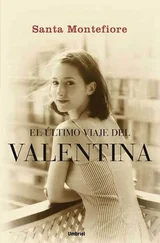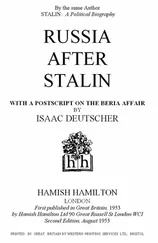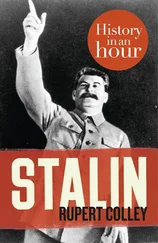* * *
Stalin’s potentates now existed in a hothouse of rarefied privilege, their offices bedecked with fine Persian carpets and broad oil paintings. [266] The size and quality of their Stalin portrait was as much a mark of rank as the stars on an officer’s shoulder boards: a life-size oil original by a court artist like Gerasimov was the sign of a potentate. Budyonny and Voroshilov also boasted life-size portraits of themselves in military splendour on horseback with sabre by Gerasimov. These “grandees” were now so pompous, recalled Svetlana, that they made “authoritative speeches” on “any pretext,” even at lunch in their own homes while their families “sighed with boredom.”
Their houses were palatial: the Moscow boss now occupied the whole of Grand Duke Sergei Alexandrovich’s palace. Stalin himself fostered this new imperial era when, after Yalta, he took a fancy to Nicholas II’s Livadia and Prince Vorontsov’s Alupka Palaces: “Put these palaces in order,” Stalin wrote to Beria on 27 February 1945. “Prepare for responsible workers.” He so liked Alexander III’s palace at Sosnovka in the Crimea that he had a dacha built there which he only visited once. Henceforth, the magnates and their children booked these palaces through the MGB 9th Department: Stepan Mikoyan honeymooned at Vorontsov’s palace; Stalin himself holidayed at Livadia. The families flew south on a special section of the State airline—Sergo Mikoyan remembers flying home on this with Poskrebyshev. The children enjoyed their privileges but had to set an example and follow Party dictums: when Zhdanov denounced jazz, Khrushchev broke his son’s beloved jazz records in a temper.
Svetlana Stalin noticed how the dachas of the Mikoyans, Molotovs and Voroshilovs were “crammed with gifts from workers… rugs, gold Caucasian weapons, porcelain” which they received like “the medieval custom of vassals paying tribute.” The magnates travelled in armoured ZiS limousines, based on the American Packards, on Stalin’s orders, followed by another “tail” of Chekists, with sirens blaring. Muscovites called this procession “a dog’s wedding.”
An entire detachment, commanded by a colonel or a general, was assigned to each leader, actually living at their dachas, half an extended family, half MGB informers. There were so many of them that each Politburo family was able to form a volleyball team, with the Berias playing the Kaganoviches. But Kaganovich refused to play on his own team: “Beria always wins and I want to be on the winning side,” he said. In MGB vernacular, the magnate was called “the subject,” their house “the object” and the guards “attachments to the subject,” so the children used to laugh when they heard them say, “The subject’s on his way to the object.” Malenkov often walked to the Kremlin from Granovsky Street surrounded by a phalanx of “attachments.”
The Politburo ladies now had their own haute couture designer. All the “top ten families” went to the atelier on Kutuzovsky Prospekt, controlled by an MGB department where Abram (Donjat Ignatovich according to Nina Khrushcheva) Lerner and Nina Adzhubei designed the men’s suits and the women’s dresses. Lerner was a traditional Jewish tailor who designed uniforms including Stalin’s Generalissimo extravaganza. If he was the Politburo’s Dior, Nina Adzhubei, “short, round, pug-nosed and very strong,” trained by “monks in a monastery,” was its Chanel. Heaps of Harper’s Bazaar and Vogue lay around. She would either copy fashions from Dior, from Vogue or Harper’s or design her own, “but she was as good as Chanel,” says her client Martha Peshkova, Beria’s daughter-in-law. “You didn’t have to pay if you didn’t ask the price,” explains Sergo Mikoyan. “My mother always paid but Polina Molotova didn’t.” This practice was finally denounced, like everything else, to Stalin who reprimanded the Politburo: Ashken Mikoyan threw the bills in Anastas’s face, proving she always paid. Adzhubei “made Svetlana Stalin’s first dress.” [267] Nina Adzhubei joined the élite herself when her son married Khrushchev’s daughter, Rada. When Khrushchev became Soviet leader, Alexei Adzhubei became powerful as his father-in-law’s adviser and Izvestiya editor.
The dressmaker was discovered by Nina Beria but Polina Molotova, the grand “first lady,” was her best client. Once the grandees of Victorian Europe had taken the waters at the Bohemian resort of Carlsbad. Now Zinaida Zhdanova and Nina Beria held court there. “Lavishly dressed and covered in furs,” with her daughter in a “mink stole,” Polina often arrived at the same spa in an official plane with an entourage of fifty. Her daughter Svetlana, a “real Bolshevik princess,” was chauffeured daily to the Institute of Foreign Relations, where many of the élite studied, arriving in a cloud of Chanel No. 5, “wearing a new outfit every day.”
Stalin retained his control of these privileges, continuing to choose the cars for every leader so that Zhdanov received an armoured Packard, a normal Packard and a ZiS 110, Beria got an armoured Packard, a ZiS and a Mercedes, while Poskrebyshev got a Cadillac and a Buick. He consoled the family of Shcherbakov, the Moscow boss who died of alcoholism, with a shower of cash. [268] Although Stalin was cynical about the renaming of places after his late magnates, he decided to build a statue and rename a region, street and factory after Shcherbakov. The original draft suggested naming a town after him, too, but Stalin crossed that out, scribbling: “Give his name to a cloth factory.” On 9 December 1947, the Politburo set annual salaries of the Premier and President at 10,000 roubles; Deputy Premiers and CC Secretaries 8,000 roubles. Stalin’s salary packets just piled up, unspent, in his desk at Kuntsevo.
Stalin specified: “Give them an apartment with a dacha, rights to the Kremlin Hospital, limousine… NKVD special staff… teacher for children…” He awarded Shcherbakov’s widow 2,000 roubles a month, his sons 1,000 a month until graduation, his mother 700 a month, his sister 300. His wife also received a lump sum of 200,000 roubles and his mother 50,000 roubles—sums of unthinkable munificence for the average worker. Here was Stalin’s new imperial order. 3
* * *
“Crown Prince” Vasily set a new standard for corruption, debauchery and caprice. Even when officers complained about him to Stalin, they used a special formula to define Vasily’s sacred place: “He is close to the Soviet people because he is your son.” Yet beneath the arrogance, Vasily was the most terrified of all the courtiers: Stalin scoffed that he would “walk through fire” if he ordered it. Vasily especially feared the future.
“I’ve only got two ways out,” he told Artyom. “The pistol or drink! If I use the pistol, I’ll cause Father a lot of trouble. But when he dies, Khrushchev, Beria and Bulganin’ll tear me apart. Do you realize what it’s like living under the axe?”
He callously abandoned his wife, Galina, taking their son Sasha to live with him at the House on the Embankment. She so longed to see Sasha that the nanny secretly met her so she could play with him. But Galina was too frightened to demand a flat or housekeeping from him. Vasily then married Marshal Timoshenko’s daughter Ekaterina, “a pretty Ukrainian.” His apartment was not grand enough for the scions of the Generalissimo and the Marshal so he demanded General Vlasik’s elegant villa on Gogolevsky. He flew back from Germany with a plane filled with “loot”: “golden ornaments, diamonds, emeralds, dozens of carpets, lots of ladies’ lingerie, a huge number of men’s suits, overcoats, fur coats, fur wraps, astrakhan” until Vasily’s house was “bursting with gold, German carpets and cut glass.” There was so much that his wife Timoshenka gradually sold it and pocketed the money. When his marriage to Timoshenka collapsed, he married a swimming star, the statuesque Kapitolina Vasileva, with whom he was happiest. Svetlana thought he was looking for his mother in his wives because he called her “mama” and she even wore her hair in a bun like Nadya.
Читать дальше
